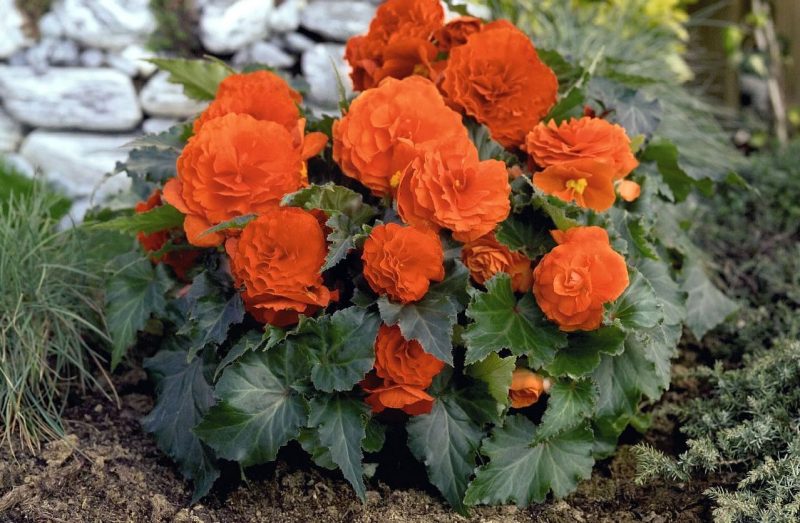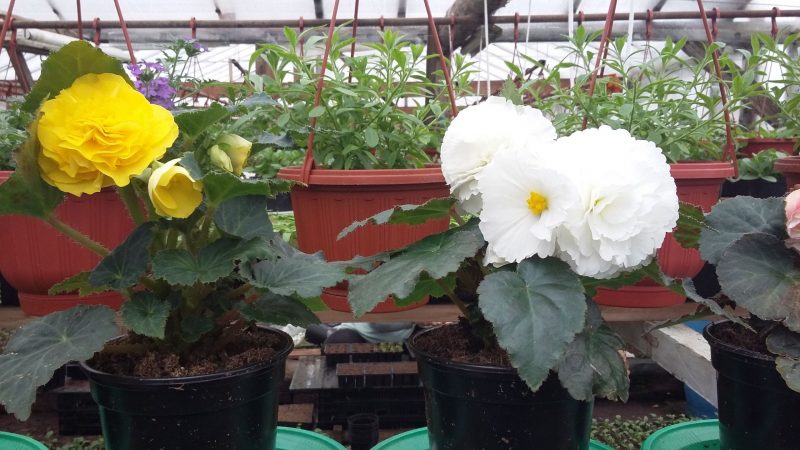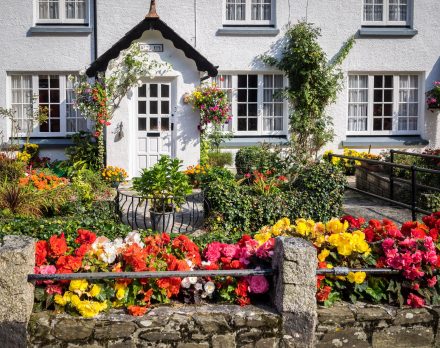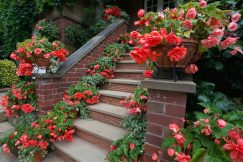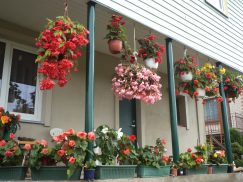Tuberous begonia is a beautifully and abundantly flowering plant of artificial origin. Numerous varieties of this flower are famous for a pleasant combination of several qualities: high decorativeness, ease of cultivation and reproduction.
Material Content:
Botanical description of the plant
The type of tuber begonia is represented by 200 varieties. Most of them are indoor plants, and some are herbaceous plants for open ground.
The main difference between tuberous forms and ordinary begonias is the presence of a root that has an unusual shape that has been modified into a tuber.
It is concave at the apex and convex at the base. The tuber grows annually and in adulthood has a diameter of 4 to 6 cm.
From the buds located on the concave side of the tuber, juicy translucent, branched and knotty shoots develop on which leaves are alternately located. In most begonias, they are large, asymmetric, obliquely heart-shaped. Leaf blades are different in shape and color: flat or corrugated, glossy or pubescent, plain green or variegated.
Tuberous begonias bloom in May, forming a large number of heterosexual flowers.
From a decorative point of view, the most interesting are men's, differing:
- large (from 4 to 20 cm) sizes;
- a variety of forms (peony, pink, bell-shaped);
- the structure of the corolla (terry, semi-double, simple);
- brightness of coloring (a wide palette of shades of white, yellow and red, with color transitions and a contrasting rim along the edge).
Female buds open later, significantly inferior to male flowers in diameter and consist of only 4 to 6 petals.
After flowering, in autumn, the ground part of the begonia withers. The plant rests for several months, existing at the tuber level and gaining strength for the next enchanting flowering.
Planting tubers in the open ground
Varieties of tuber begonias for open ground prefer to grow in well-lit areas or in light shade, on loose nutrient soils.
Planting tuber begonia in the open ground is carried out in the spring, after the complete disappearance of the threat of frost.
Compliance with this condition is mandatory - the begonias are thermophilic. Minus temperatures, starting from –1 ° C, are destructive for them. For this reason, some gardeners practice the cultivation of tubers at home with their subsequent transplantation (transshipment).
Tuber growing is especially important for the northern territories of the central zone of Russia, where frosts are frequent at the end of May and even the beginning of June. During the day, the flowers are taken out into the open air, and again returned to the room at night. This tactic eliminates the risk of losing the plant from low temperatures and allows you to get earlier flowering.
Watering, fertilizer, pruning
Caring for tuberous begonias is simple and consists of watering, fertilizing and pruning when preparing the plant for the period of winter rest.
- Watering. Begonias moisturize abundantly 1 to 3 times a week, preventing both complete drying of the soil and accumulation of moisture in the pallet. For irrigation, water at room temperature, which has been kept for 24 hours, is used. With the onset of flowering, moisture is gradually reduced and stopped when there are clear signs of flower preparation for winter sleep.
- Fertilizer application. In spring, during the active growth of shoots, begonias are weekly fed with complex fertilizers for flowering plants in a concentration reduced by half compared with the recommended one. During the flowering period, the frequency of top dressing is reduced to 1 time per month and completely stopped by the beginning of dormancy.
- Preparation for the rest period. In September, the lower leaves of begonias turn yellow and fall - so the flower prepares for rest. At this time, pruning is carried out, shortening the shoots to a height of 6 - 7 cm. Every 2 - 3 days, the stump is checked for strength, slightly rocking with a finger. It should easily separate from the tuber. As soon as this happens, an earthen lump is removed from the container. The tuber is freed from the soil, dried for 1 - 2 hours, then wrapped in paper or placed in paper bags and stored until February in a cool dark place (up to 8 ° C). For example, in the compartment for vegetables in the refrigerator. Tubers are inspected monthly. The rotten areas are removed by disinfecting the slices with coal powder or ash.
It is interesting:evergreen begonia at home
Propagation of a flower at home
Tuber begonia at home easily and simply propagates vegetatively.
Tuber division is carried out in February, selecting the largest, with already awakened buds, but still without sprouts.
- With a sharp knife, the tuber is cut into several parts so that each has at least one awakened kidney.
- Parts of the tuber are dried by first disinfecting the slices.
- Each planted in a separate pot and looked after in the usual way.
Tuberous begonias can be propagated by cuttings that are harvested in spring or early summer. At this time, the mother plant tolerates pruning easier, and rooting is faster.
- As cuttings, take the tops or side branches of shoots with a length of not more than 10 cm, having from 1 to 3 leaves. In the case of the development of a dense bush, a young shoot independently growing from a tuber can be twisted.
- Cuttings are rooted in water or soil. The roots grow within a month.
- Until autumn, young begonias form a very small (up to 2 cm) tuber, so in the first year of life they are not sent for winter holidays.
Begonia can also be grown from seeds that are on sale.Unlike the vegetative method, seed propagation of tuber begonia is a long and laborious process, therefore it is used less often at home.
Diseases, pests and methods for their treatment
Tuberous begonias are prone to fungal infections caused by increased soil moisture, low temperatures or their sharp fluctuation.
Signs of the appearance of fungal infections are:
- slow development of the plant;
- lethargy and drooping leaves;
- the formation of a small number of buds;
- falling of unopened flowers.
The diseased plant is treated with fungicides. When the first signs are detected, several soil and ground treatments are carried out with fungicides of biological origin (Fitosporin). In advanced cases, chemicals are used (Vitaros, Maxim).
Read also:phytosporin - instructions for use
High humidity and cool air provoke the development of powdery mildew, manifested by the formation of white plaque on leaves and shoots. The lesion is treated with insecticides and correction of the conditions for the growth of the flower.
Large leaves of begonias attract sucking insects. The greatest danger is thrips and whitefly.
- Thrips settle inside the buds, causing them to fade, deform and fall off.
- Whitefly lays eggs on the underside of leaves. Affected parts of the plant will lose turgor, gradually deform and wither.
Pest insects are destroyed by systemic fungicides, and the best prevention of their appearance is competent care.
The spider mite, which develops in very dry air, is a malicious and dangerous pest of tuberous begonias. The formation of a gray rough coating on the leaves and a thin cobweb between the shoots testifies to its appearance. The diseased plant is isolated and treated with acaricides (Fitoverm, Apollo, Neoron).
Tuberous begonia in the garden: ideas for inspiration
The rich colors and splendor of flowering begonias are not inferior to roses, camellias and dahlias, and the variety of shapes and colors allows you to realize original and bold ideas for decorating flower beds, lawns and flower beds:
- Bright begonias on a green background of a well-groomed lawn look very impressive.
- Growing several varieties of begonias, different in the color of the buds, allows you to achieve the effect of a bright floral carpet. Varying the height of the shoots and the transition of shades allows you to make its surface “live”, showing its movement.
- These works of art look like begonia flower beds, decorated in the form of stripes, circles, mosaics or panoramic paintings.
- Incredibly good planting of tuberous begonias on the slopes of the hills. The location on the top of low-growing varieties with a gradual increase in shoot height below growing plants allows you to get the effect of a color path running away into the sky.
- Ampel begonias grown in pots and flowerpots suspended with iron hooks from the branches of trees look spectacular.
- Unique begonias garlands decorating the entrance to the premises, verandas and arbors.
Caring for begonias is not complicated, but it gives a huge scope for imagination. This unpretentious beauty will be the best decoration of the garden.




